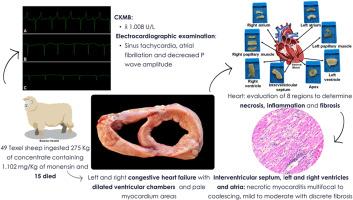Morbity and mortality in Texel sheep following feed-based monensin overdose in Brazil
IF 2.4
4区 医学
Q2 PHARMACOLOGY & PHARMACY
引用次数: 0
Abstract
Monensin is an antibiotic ionophore used as feed additive in production animals, however, overdose with monensin is associated with poisoning in livestock. This study describes a mortality outbreak in sheep associated with ingestion of a feed supplement containing elevated concentrations of monensin. The objectives were characterize pathological lesions from monensin toxicosis, correlate these findings with serum creatine kinase myocardial band (CKMB) to estimate the extent of myocardial injury, as well as with electrocardiogram to evaluate the progression and severity of cardiac damage. A farm with 49 Texel sheep provided 275 Kg of supplement containing 1.102 mg/kg of monensin undiluted, freely available in the trough for seven days (40 Kg/day). From the 5th day onward animals presented sternal recumbency, submandibular edema, dyspnea and tachycardia followed by death in 15 animals. At necropsy, the main lesions were globular heart with eccentric dilatation of cardiac chambers, pale myocardium, lungs with edema and congestion, hydrothorax, hydropericardium, ascites, liver with enhanced lobular pattern and pale skeletal musculature. Histologically, in six sheep that died within the first days necrotic myocarditis multifocal to coalescing, mild to moderate with discrete degree of fibrosis, and in nine sheep that died later fibrosis became pronounced. Mapping of cardiac lesions revealed predominance of lesions in left and right ventricles, atria, and interventricular septum, with degree varying between 2 and 3. In apex, right and left papillary muscles lesions ranged from grades 0–2. There was evidence of discrete multifocal necrotic myositis, pulmonary edema and congestion, necrotic hepatitis and centrilobular congestion. In the animals which the CKMB enzyme was measured, the mean value was 1008.88 u/L (104-2480 u/L). Electrocardiogram in four animals showed sinus tachycardia, atrial fibrillation and decreased wave P amplitude. Monensin poisoning caused predominant damage to heart with right and left congestive heart failure, which continued to be present in the surviving animals.

巴西以饲料为基础的莫能菌素过量后特塞尔羊的发病率和死亡率
莫能菌素是一种抗生素离子载体,用于生产动物的饲料添加剂,然而,过量使用莫能菌素与牲畜中毒有关。本研究描述了与摄入含有高浓度莫能菌素的饲料补充剂相关的绵羊死亡暴发。目的是表征莫能菌素中毒的病理病变,将这些结果与血清肌酸激酶心肌带(CKMB)相关联,以估计心肌损伤的程度,并与心电图相关联,以评估心脏损伤的进展和严重程度。一个拥有49只特塞尔羊的农场提供了275公斤含有1.102毫克/公斤未稀释莫能菌素的补充物,在槽中免费提供7天(40公斤/天)。从第5天开始,15只动物出现胸骨平躺、下颌下水肿、呼吸困难和心动过速,随后死亡。尸检时,主要病变为球形心脏,心室偏心扩张,心肌苍白,肺水肿充血,胸水,心包水,腹水,肝小叶型增强,骨骼肌苍白。组织学上,在头几天死亡的6只羊中,坏死性心肌炎多灶性合并,轻度至中度伴有离散程度的纤维化,而在后来死亡的9只羊中,纤维化变得明显。心脏病变作图显示左、右心室、心房、室间隔病变居多,程度在2 ~ 3之间。在顶端,左右乳头肌病变从0-2级不等。有证据表明离散多灶性坏死性肌炎,肺水肿和充血,坏死性肝炎和小叶中心充血。CKMB酶测定动物的平均值为1008.88 u/L (104 ~ 2480 u/L)。4只动物的心电图表现为窦性心动过速、心房颤动、P波振幅降低。莫能菌素中毒对心脏的主要损害是右充血性和左充血性心力衰竭,这种情况在幸存的动物中继续存在。
本文章由计算机程序翻译,如有差异,请以英文原文为准。
求助全文
约1分钟内获得全文
求助全文
来源期刊

Toxicon
医学-毒理学
CiteScore
4.80
自引率
10.70%
发文量
358
审稿时长
68 days
期刊介绍:
Toxicon has an open access mirror Toxicon: X, sharing the same aims and scope, editorial team, submission system and rigorous peer review. An introductory offer Toxicon: X - full waiver of the Open Access fee.
Toxicon''s "aims and scope" are to publish:
-articles containing the results of original research on problems related to toxins derived from animals, plants and microorganisms
-papers on novel findings related to the chemical, pharmacological, toxicological, and immunological properties of natural toxins
-molecular biological studies of toxins and other genes from poisonous and venomous organisms that advance understanding of the role or function of toxins
-clinical observations on poisoning and envenoming where a new therapeutic principle has been proposed or a decidedly superior clinical result has been obtained.
-material on the use of toxins as tools in studying biological processes and material on subjects related to venom and antivenom problems.
-articles on the translational application of toxins, for example as drugs and insecticides
-epidemiological studies on envenoming or poisoning, so long as they highlight a previously unrecognised medical problem or provide insight into the prevention or medical treatment of envenoming or poisoning. Retrospective surveys of hospital records, especially those lacking species identification, will not be considered for publication. Properly designed prospective community-based surveys are strongly encouraged.
-articles describing well-known activities of venoms, such as antibacterial, anticancer, and analgesic activities of arachnid venoms, without any attempt to define the mechanism of action or purify the active component, will not be considered for publication in Toxicon.
-review articles on problems related to toxinology.
To encourage the exchange of ideas, sections of the journal may be devoted to Short Communications, Letters to the Editor and activities of the affiliated societies.
 求助内容:
求助内容: 应助结果提醒方式:
应助结果提醒方式:


